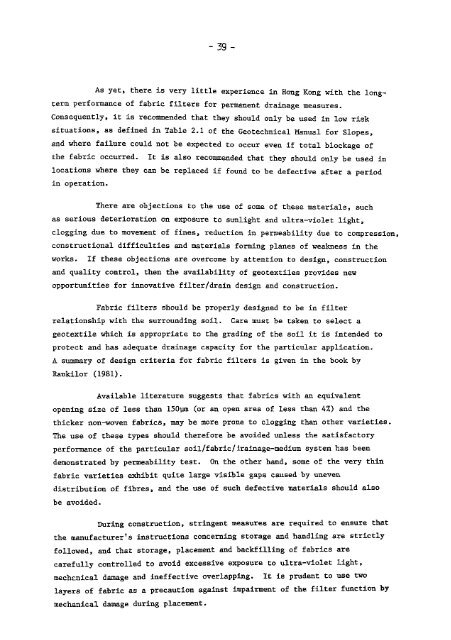4 - HKU Libraries
4 - HKU Libraries
4 - HKU Libraries
Create successful ePaper yourself
Turn your PDF publications into a flip-book with our unique Google optimized e-Paper software.
- 39 -As yet, there Is very little experience In Hong Kong with the longtermperformance of fabric filters for permanent drainage measures.Consequently, it is recommended that they should only be used in low risksituations, as defined in Table 2.1 of the Geotechnical Manual for Slopes,and where failure could not be expected to occur even if total blockage ofthe fabric occurred. It is also recommended that they should only be used inlocations where they can be replaced if found to be defective after a periodin operation.There are objections to the use of some of these materials, suchas serious deterioration on exposure to sunlight and ultra-violet light,clogging due to movement of fines, reduction in permeability due to compression,constructional difficulties and materials forming planes of weakness in theworks. If these objections are overcome by attention to design, constructionand quality control, then the availability of geotextiles provides newopportunities for innovative filter/drain design and construction.Fabric filters should be properly designed to be in filterrelationship with the surrounding soil. Care must be taken to select ageotextile which is appropriate to the grading of the soil it is intended toprotect and has adequate drainage capacity for the particular application.A summary of design criteria for fabric filters is given in the book byRankilor (1981).Available literature suggests that fabrics with an equivalentopening size of less than 150ym (or an open area of less than 4%) and thethicker non-woven fabrics, may be more prone to clogging than other varieties.The use of these types should therefore be avoided unless the satisfactoryperformance of the particular soil/fabric/Irainage-medium system has beendemonstrated by permeability test. On the other hand, some of the very thinfabric varieties exhibit quite large visible gaps caused by unevendistribution of fibres, and the use of such defective materials should alsobe avoided.During construction, stringent measures are required to ensure thatthe manufacturer's instructions concerning storage and handling are strictlyfollowed, and that storage, placement and backfilling of fabrics arecarefully controlled to avoid excessive exposure to ultra-violet light,mechcnical damage and ineffective overlapping. It is prudent to use twolayers of fabric as a precaution against impairment of the filter function bymechanical damage during placement.

















